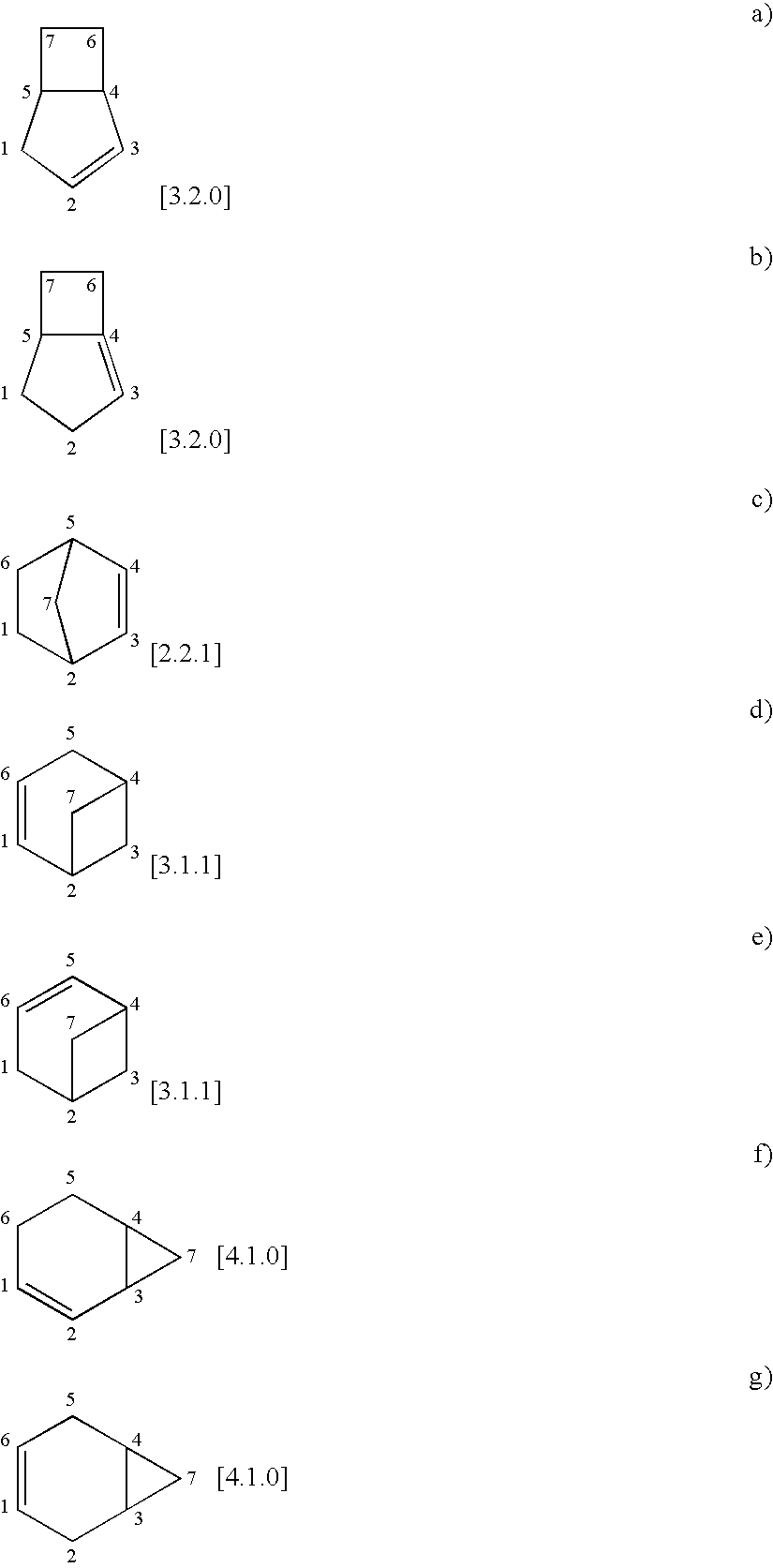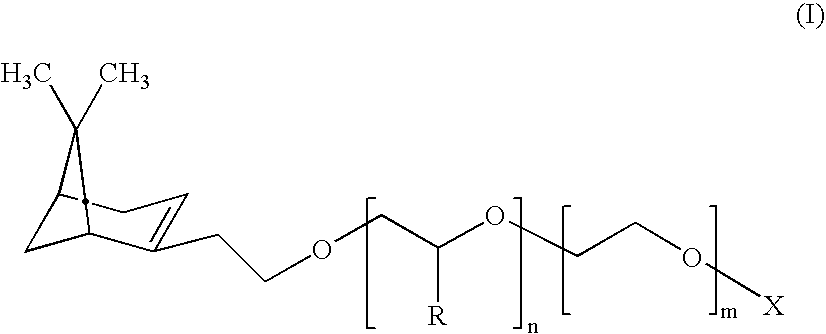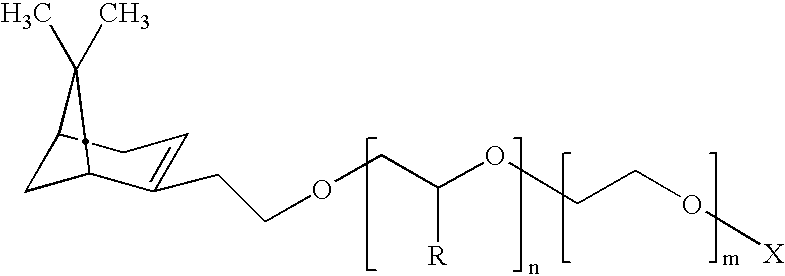Use of polyoxypropylene and polyoxyethylene terpene compounds in emulsion polymerization
a technology of emulsion polymerization and polyoxyethylene, which is applied in the direction of detergent compounding agents, chemical/physical processes, detergent compositions, etc., can solve the problems of paint or coating foaming, dewetting of coating, adverse effects of paint or coating, etc., and achieve the effect of improving properties
- Summary
- Abstract
- Description
- Claims
- Application Information
AI Technical Summary
Benefits of technology
Problems solved by technology
Method used
Image
Examples
example 1
[0028] Latex trials 1 to 13 were prepared using the following formulation:
Description: Acrylic Pressure Sensitive Adhesive LatexTotal Solids (by formula): 55%FormulaActiveWt (g)Wt (g)% BOTM1Kettle ChargeDeionized Water 191.50 0.00 0.00%Sodium Bicarbonate 0.55 0.55 0.10% 192.05 0.55Monomer EmulsionDeionized Water 154.1 0.00 0.00%Surfactant 5.50 3.19 0.58%Butyl acrylate 533.5533.5097.00%Hydroxyethyl acrylate 11.0 11.00 2.00%Acrylic acid 5.5 5.50 1.00% 709.6553.19550.0 = grams total monomerInitiator SolutionDeionized Water 107.0 0.00 0.00%Ammonium Persulfate 2.2 2.20 0.40% 109.2 2.20Total1010.8555.94Reactor setup:1200 ml 2 piece glass kettle reactorOverhead mixer with glass shaft / Teflonpaddle bladePROCEDURE1.Heat kettle charge to 80° C. while purging with nitrogen. Maintainnitrogen purge throughout run.Adjust agitation for homogeneous mixing throughout run.2.Add 5% of monomer emulsion (35.5 g). Wait 5 minutes fortemperature to rebound.3.Add 25% (27.3 g) of initiator solution and...
example 2
[0039] Latex trials 14 to 27 were prepared using the following formula:
Description: Acrylic Paint LatexTotal Solids (by formula): 51%FormulaActive%wt (g)Wt (g)BOTM1Kettle ChargeDeionized Water 191.22 0.00 0.00%Surfactant 1.74 1.02 0.20% 192.96 1.02Monomer EmulsionDeionized Water 191.67 0.00 0.00%Surfactant 15.37 9.02 1.80%Methyl methacrylate 260.00260.0052.00%Butyl acrylate 235.00235.0047.00%Methacrylic acid 5.00 5.00 1.00% 707.04509.02500.00 = grams total monomerInitiator SolutionDeionized Water 98.00 0.00 0.00%Ammonium Persulfate 2.00 2.00 0.40% 100.00 2.00Total1000.00512.04Reactor setup:1200 ml 2 piece glass kettle reactorOverhead mixer with glass shaft / Teflonpaddle bladePROCEDURE1.Heat kettle charge to 82° C. while purging with nitrogen. Maintainnitrogen purge throughout run.Adjust agitation for homogeneous mixing throughout run.2.Add 2% of monomer emulsion (14.14 g). Wait 5 minutes fortemperature to rebound.3.Add 25% (25.0 g) of initiator solution and hold at 80° C. for 1...
example 3
[0044] Latex trials 28 to 32 were prepared using the following formula:
Description: Vinyl Acrylic Paint LatexTotal Solids (by formula): 51.7%FormulaActive%wt (g)Wt (g)BOTM1Kettle ChargeDeionized Water 199.50 0.00 0.00%Sodium Bicarbonate 0.50 0.50 0.10% 200.00 0.50Monomer EmulsionDeionized Water 154.26 0.00 0.00%Surfactant A 25.85 7.50 1.50%Surfactant B 7.69 5.00 1.00%Sodium Bicarbonate 1.50 1.50 0.30%Vinyl acetate 400.00400.0080.00%Butyl acrylate 92.50 92.5018.50%Acrylic acid 7.50 7.50 1.50% 689.30514.00500.00 = grams totalmonomerInitiator SolutionDeionized Water 98.00 0.00 0.00%Sodium Persulfate 2.00 2.00 0.40% 100.00 2.00Chaser SolutionsDeionized Water 5.00 0.00 0.00%T-BHP (70%)2 0.40 0.28 0.06% 0.00 0.00%Deionized Water 5.00 0.00 0.00%Isoascorbic acid 0.30 0.30 0.06% 0.00 0.00% 10.70 0.58Total1000.00517.08Reactor setup:1200 ml 2 piece glass kettle reactorOverhead mixer with glass shaft / Teflonpaddle bladePROCEDURE1.Heat kettle charge to 80° C. while purging with nitroge...
PUM
| Property | Measurement | Unit |
|---|---|---|
| temperature | aaaaa | aaaaa |
| temperature | aaaaa | aaaaa |
| temperature | aaaaa | aaaaa |
Abstract
Description
Claims
Application Information
 Login to View More
Login to View More - R&D
- Intellectual Property
- Life Sciences
- Materials
- Tech Scout
- Unparalleled Data Quality
- Higher Quality Content
- 60% Fewer Hallucinations
Browse by: Latest US Patents, China's latest patents, Technical Efficacy Thesaurus, Application Domain, Technology Topic, Popular Technical Reports.
© 2025 PatSnap. All rights reserved.Legal|Privacy policy|Modern Slavery Act Transparency Statement|Sitemap|About US| Contact US: help@patsnap.com



